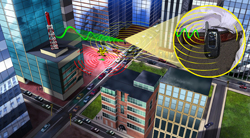 Years ago, if you wanted to take a picture, you needed a dedicated camera. You needed to buy batteries for it, keep it charged, learn its controls, and lug it around. Today, chances are your cell phone is called a “smartphone” and came with a three-to-five megapixel lens built-in—not to mention an MP3 player, GPS, or even a bar code scanner.
Years ago, if you wanted to take a picture, you needed a dedicated camera. You needed to buy batteries for it, keep it charged, learn its controls, and lug it around. Today, chances are your cell phone is called a “smartphone” and came with a three-to-five megapixel lens built-in—not to mention an MP3 player, GPS, or even a bar code scanner.
This Swiss Army knife trend represents the natural progression of technology—as chips become smaller and more advanced, cell phones continue to absorb new functions. Yet, in the future, these new functions may not only make our lives easier, they could also protect us—and maybe even save our lives.
The Cell-All initiative may be one such savior. Spearheaded by the Department of Homeland Security’s (DHS) Science and Technology Directorate (S&T), Cell-All aims to equip your cell phone with a sensor capable of detecting deadly chemicals at minimal cost—to the manufacturer (a buck a sensor) and to your phone’s battery life. “Our goal is to create a lightweight, cost-effective, power-efficient solution,” says Stephen Dennis, Cell-All’s program manager.
How would this wizardry work? Just as antivirus software bides its time in the background and springs to life when it spies suspicious activity, so Cell-All regularly sniffs the surrounding air for certain volatile chemical compounds.
When a threat is sensed, a virtual ah-choo! ensues in one of two ways. For personal safety issues such as a chlorine gas leak, a warning is sounded; the user can choose a vibration, noise, text message, or phone call. For catastrophes such as a sarin gas attack, details—including time, location, and the compound—are phoned home to an emergency operations center.
While the first warning is beamed to individuals—a grandmother taking a siesta or a teenager hiking through the woods—the second warning works best with crowds. And that’s where the genius of Cell-All lies—in crowdsourcing human safety.
Currently, if a person suspects that something is amiss, he might dial 9-1-1, though behavioral science tells us that it’s easier to do nothing. If he does do something, it may be at a risk to his own life. And as is often the case when someone phones in an emergency, the caller may be frantic and difficult to understand, diminishing the quality of information that’s relayed to first responders. An even worse scenario: the person may not even be aware of the danger, like the South Carolina woman who last year drove into a colorless, odorless, and poisonous ammonia cloud.
In contrast, anywhere a chemical threat breaks out—a mall, a bus, subway, or office—Cell-All will alert the authorities automatically. Detection, identification, and notification all take place in less than 60 seconds. Because the data are delivered digitally, Cell-All reduces the chance of human error. And by activating alerts from many people at once, Cell-All cleverly avoids the longstanding problem of false positives. The end result: emergency responders can get to the scene sooner and cover a larger area—essentially anywhere people are—casting a wider net than stationary sensors can.
But what about your privacy? Does this always-on surveillance mean that the government can track your precise whereabouts whenever it wants? To the contrary, Cell-All will operate only on an opt-in basis and will transmit data anonymously. “Privacy is as important as technology,” avers Dennis. “After all, for Cell-All to succeed, people must be comfortable enough to turn it on in the first place.”
For years, the idea of a handheld weapons of mass destruction detector has engaged engineers. In 2007, S&T called upon the private sector to develop concepts of operations. Today, thanks to increasingly successful prototype demonstrations, the Directorate is actively funding the next step in R&D—a proof of principle—to see if the concept is workable.
To this end, three teams from Qualcomm, the National Aeronautics and Space Administration (NASA), and Rhevision Technology are perfecting their specific area of expertise. Qualcomm engineers specialize in miniaturization and know how to shepherd a product to market. Scientists from the Center for Nanotechnology at NASA’s Ames Research Center have experience with chemical sensing on low-powered platforms, such as the International Space Station. And technologists from Rhevision have developed an artificial nose—a piece of porous silicon that changes colors in the presence of certain molecules, which can be read spectrographically.
Similarly, S&T is pursuing what’s known as cooperative research and development agreements with four cell phone manufacturers: Qualcomm, LG, Apple, and Samsung. These written agreements, which bring together a private company and a government agency for a specific project, often accelerate the commercialization of technology developed for government purposes. As a result, Dennis hopes to have 40 prototypes in about a year, the first of which will sniff out carbon monoxide and fire.
To be sure, Cell-All’s commercialization may take several years. Yet the goal seems imminently achievable: Just as Bill Gates once envisioned a computer on every desk in every home, so Stephen Dennis envisions a chemical sensor in every cell phone in every pocket, purse, or belt holster. If it’s not already the case, our smartphones may soon be smarter than we are.
To request more information about this story, please e-mail st.snapshots@hq.dhs.gov.
